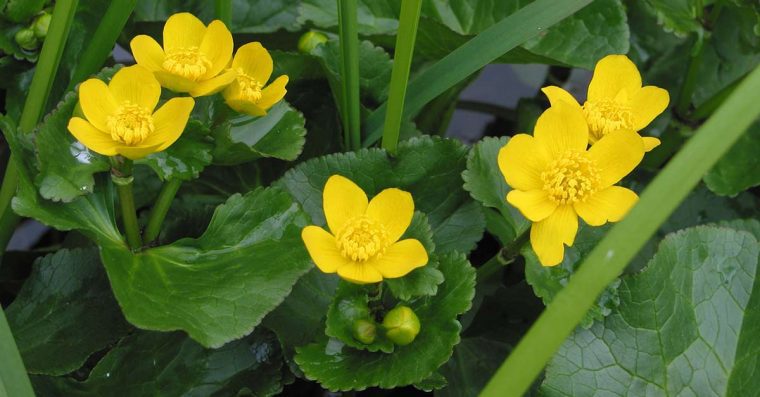Printed from: https://finalhbks.asgoodasready.com/wildflowers/marsh-marigold/
Scientific name: Caltha palustris
Family: Ranunculaceae (Buttercup)
Marsh Marigold is a herbaceous perennial found in wet woodlands, damp meadows and along stream banks. It also grows well in the shallow margins of a pond.
This hairless, stout wildflower resembles a buttercup (it is, after all, from the buttercup family). However, there are a few features that help to distinguish it from other buttercups.
The flowers of Marsh Marigold are larger than those of a buttercup and they are also more golden yellow in colour. The dark green leaves are large and kidney-shaped with a glossy appearance, usually with two lobes at the base. The stems are long and hollow. The leaves are small when the flowers are open, but they will keep growing into larger leaves, up to 10 cm across, whenever the flowers fade.
The Marsh Marigold’s brilliant yellow flowers are about 15-50mm across, usually with 5 petal-like sepals and an abundance of yellow stamens and ovary-bearing structures (carpels) in the centre. A sepal is usually green and is the leaf-like structure that encloses and protects the unopened flower bud. For many plants, these sepals open out and drop to reveal the petals underneath, however with this species the sepals open and become what appear to be yellow petals.
Marsh Marigold is one of the first wetland wildflowers to bloom early in the spring. This makes it a welcome early source of pollen and nectar for many insects such as hoverflies, the large bee-fly – a bee mimic – (Bombylius major) and the honeybee. On the banks of a pond or river, it creates an excellent ground cover and provides shelter for frogs and other waterside inhabitants.
Its scientific name derives from the Greek word calathos meaning “cup” or “goblet”. It relates to the flower’s shape. The specific name palustris, from the Latin meaning “of a marsh”, refers to its common habitat.
Marsh Marigold has many different common names but is most often referred to as King Cup, May-blobs and Water-bubbles. The common name Marigold refers to its use in church festivals in the Middle Ages, as one of the flowers devoted to the Virgin Mary. It is sometimes referred to as Mayflower and the name comes from the custom on May Day festivals, when flowers were scattered on cottage doorsteps and plaited for decoration on Old May Eve. It is also a plant often referred to in literature, including Shakespeare; “Winking Marybuds begin to ope their golden eyes”.
Marsh Marigold contains harmful toxins and an alkaloid poison. As a result, all parts of the plant can be an irritant and it has been known to cause skin rashes and dermatitis. Although poisonous when raw, the stems, leaves and roots are sometimes cooked and eaten as a vegetable.
Marsh Marigold has also been used for medicinal purposes, from the removal of warts to the treatment of fits and anaemia. Various preparations of the roots are used in the treatment of colds and sores and a tea made from the leaves will act as a laxative.
Propagation
From seed
This plant is widely dispersed by reseeding itself in situ. Marsh Marigold can be propagated by sowing fresh seed in the summer although, if grown in this way, they won’t bloom until the following year.
By division
Dividing root clumps before flowers appear in early spring or when plants are dormant in summer is probably the easiest way to propagate Marsh Marigold.

